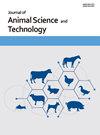A comparison of the physiochemical features of three tertiary hybrid pigs with and without spent coffee ground supplementation
IF 3.2
3区 农林科学
Q1 AGRICULTURE, DAIRY & ANIMAL SCIENCE
引用次数: 0
Abstract
The objective of this experiment was to evaluate the physiochemical characteristics of three tertiary hybrids (crossbreeds) of pigs, with and without coffee supplementation. A total of fifty pigs of different mixed breeds Landrace × Yorkshire × Duroc (LYD), Yorkshire × Berkshire (YB), and Yorkshire × Woori (YW); 113.45 kg ±3.33 kg) at age 190 days old were employed to measure the effect of spent coffee grounds from Gangneung-Si area of South Korea on the meat quality of pigs in the pigsty at the Kangwon National University Teaching and Research Farm using the 2 × 2 factorial arrangements. Our result shows that the fat percentage was higher (P<0.05) in YB and YW. pH was higher (p<0.05) in the YB breed. Meat colour a* was higher (p<0.05) in the YB and YW breeds. Meat colour b* was higher (p<0.05) in YW. Water holding capacity was higher (p<0.05) in the YB and YW breeds. Drip loss 6 was lower (p<0.05) in YB and YW. Cooking loss was higher (p<0.05) in LYD and YW breeds. The fatty acid components such as linolenic (C18:2), myristic (C14:0), and palmitoleic (C16:1) were higher (p<0.05) in the YB. Palmitic (C16:0), stearic (C18:0), and arachidic (C20:0) was higher (p<0.05) in YW. Lignoceric (C24:0) was higher (p<0.05) in LYD and YW. Unsaturated fatty acid (UFA) was higher (p<0.05) in YB and YW, while Polyunsaturated fatty acid (PUFA) was higher (p<0.05) in YB. Monosaturated fatty acid (MUFA) / PUFA was higher (p<0.05) in LYD. Saturated fatty acid (SFA) was higher (p<0.05) in YW. UFA and MUFA were higher (p<0.05) in the YB. MUFA / PUFA were higher (p=0.05) in YB. We concluded from our results that YW and YB had close meat qualities in terms of firmness and flavour compared to LYD as the physiochemical characteristics of meat were improved. SCG supplemented at 0.5% had no detrimental effect on the parameters measured.三种三级杂交猪添加和未添加废咖啡粉的理化特性比较
本试验的目的是评价3个三级杂交猪在添加和不添加咖啡的情况下的理化特性。选用长×约克×杜洛克(LYD)、约克×伯克郡(YB)、约克×友利(YW)不同杂交品种猪50头;采用2 × 2因子法,测定了韩国江陵市地区咖啡渣对江原国立大学教学研究农场猪舍猪肉质的影响。结果表明,YB和YW的脂肪率较高(P<0.05)。YB品种的pH值较高(p<0.05)。YB和YW品种肉色a*较高(p<0.05)。YW组肉色b*较高(p<0.05)。YB和YW品种的持水能力较高(p&p;lt;0.05)。YB和YW的滴漏损失6较低(p<0.05)。LYD和YW品种蒸煮损失较高(p<0.05)。亚麻酸(C18:2)、肉豆蔻酸(C14:0)和棕榈油酸(C16:1)等脂肪酸成分在YB中含量较高(p < 0.05)。棕榈脂质(C16:0)、硬脂质(C18:0)和花生脂质(C20:0)含量较高(p < 0.05)。LYD和YW组的Lignoceric (C24:0)较高(p&p;lt;0.05)。YB和YW的不饱和脂肪酸(UFA)含量较高(p<0.05), YB的多不饱和脂肪酸(PUFA)含量较高(p<0.05)。LYD组单饱和脂肪酸(MUFA) / PUFA较高(p < 0.05)。饱和脂肪酸(SFA)较高(p<0.05)。YB组UFA和MUFA较高(p < 0.05)。YB组MUFA / PUFA较高(p=0.05)。结果表明,由于肉的理化特性得到改善,YW和YB在肉质硬度和风味方面与LYD相近。添加0.5%的SCG对所测参数没有不利影响。
本文章由计算机程序翻译,如有差异,请以英文原文为准。
求助全文
约1分钟内获得全文
求助全文
来源期刊

Journal of Animal Science and Technology
Agricultural and Biological Sciences-Food Science
CiteScore
4.50
自引率
8.70%
发文量
96
审稿时长
7 weeks
期刊介绍:
Journal of Animal Science and Technology (J. Anim. Sci. Technol. or JAST) is a peer-reviewed, open access journal publishing original research, review articles and notes in all fields of animal science.
Topics covered by the journal include: genetics and breeding, physiology, nutrition of monogastric animals, nutrition of ruminants, animal products (milk, meat, eggs and their by-products) and their processing, grasslands and roughages, livestock environment, animal biotechnology, animal behavior and welfare.
Articles generally report research involving beef cattle, dairy cattle, pigs, companion animals, goats, horses, and sheep. However, studies involving other farm animals, aquatic and wildlife species, and laboratory animal species that address fundamental questions related to livestock and companion animal biology will also be considered for publication.
The Journal of Animal Science and Technology (J. Anim. Technol. or JAST) has been the official journal of The Korean Society of Animal Science and Technology (KSAST) since 2000, formerly known as The Korean Journal of Animal Sciences (launched in 1956).
 求助内容:
求助内容: 应助结果提醒方式:
应助结果提醒方式:


